Coronavirus (COVID-19): state of the epidemic - 26 March 2021
This report brings together the different sources of evidence and data about the coronavirus epidemic to summarise the current situation, why we are at that place, and what is likely to happen next.
This document is part of a collection
State of the Epidemic in Scotland (26th March 2021)
Background
This report summarises the current situation on the COVID-19 epidemic in Scotland. It brings together the different sources of evidence and data about the epidemic in Scotland at this point in time, why we are at that place, and what is likely to happen next. This summarises the data up to and including the 25 March 2021 on COVID-19 in Scotland. This updates the previous publication published on 19 March 2021[1]. The information in this document helps the Scottish Government, the health service and the wider public sector respond to the epidemic and put in place what is needed to keep us safe and treat people who have the virus.
This edition of the state of the epidemic, summarises current data on COVID-19 at a national level, at a local level and how Scotland currently compares to the rest of the UK. It looks at the vaccination program in Scotland and the effects which are beginning to be seen from this. Information is provided about variants of concern and what impact these may have. Bringing this information together in one place gives the opportunity to better understand the current state of the epidemic in Scotland.
Key Points
- The reproduction rate R in Scotland is currently estimated as being between 0.8 and 1.0.
- An average of 552 cases were reported per day in the 7 days to 25 March, which is a 6% decrease in reported cases since the 18 March.
- There were 71 weekly cases per 100,000 in the week to 22 March, which is a slight decrease since last week. This compares to 302 weekly cases per 100,000 on 8 January and is similar to the weekly case rate observed at the end of September.
- Case rates in most age groups have slightly decreased, with a slight increase in cases in those aged 0-19 this week.
- The estimated proportion of people becoming infected with Covid in Scotland has increased slightly this week and is now above England, Northern Ireland, and Wales as determined through the weekly ONS survey.
- Latest modelled estimates suggest there are currently between 13 and 30 new daily infections per 100,000 people in Scotland.
- Average daily deaths per 100,000 population in Scotland (0.09) are above Northern Ireland (0.06) but below England (0.12) and Wales (0.13).
- West Lothian currently has the highest weekly case rate in Scotland reporting 209 cases per 100,000 in the last week, while Argyll and Bute, Orkney and Scottish Borders reported under 10 cases each in the same time.
- At a national level hospital bed and ICU occupancy are projected to fall over the next few weeks, but with the potential to plateau or increase as a result of schools reopening.
- Over 2.2 million people in Scotland have now been vaccinated against SARS-CoV-2, with the initial target for older care home residents having been surpassed.
- The current UK variant of concern has been increasing its share of confirmed cases since it was first detected in Scotland in mid-December and is now the dominant strain.
Method
This report brings together a wide range of publically available figures from a range of data sources. These include publications by Scottish Government, Public Heath Scotland, National Records of Scotland, Office for National Statistics along with scientific publications and SAGE summaries where appropriate to summarise the state of the epidemic in Scotland in a given week. We also provide information on public attitudes to the virus from weekly You Gov polling surveys.
The national picture
The latest R value for Scotland (published on 25 March)[2] has increased and was between 0.8 and 1.0 (Figure 1), with a growth rate of between -4% and -1%.
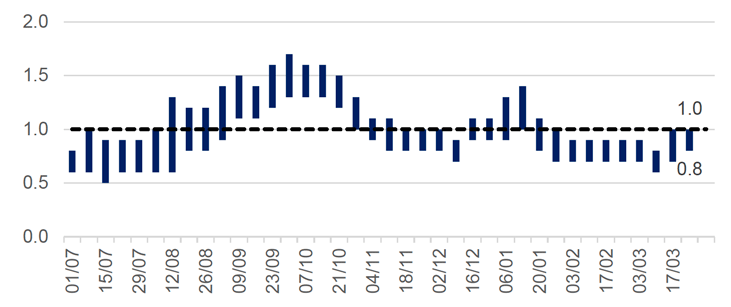
Since they were introduced in early January at a national level we have seen the impact of stay at home measures in reducing the level of SARS-CoV-2 in Scotland. An average of 552 cases were reported per day in the 7 days to 25 March, this is a 6% decrease from the daily average cases recorded a week earlier to 18 March[3]. Average daily cases reported are now under a quarter of the peak of 2,323 in the week to 7 January. Our current position is 71 weekly cases per 100,000 in the week to 22 March[4]. This compares to 302 weekly cases per 100,000 on 8 January and is similar to the weekly case rate observed at the end of September (see Figure 2)[4].
Levels of Covid in wastewater are monitored at 28 sites around Scotland. In contrast to COVID-19 case records, virus shedding into wastewater is a biological process. This means that wastewater data is unaffected by factors that impact whether testing is done. The overall level of wastewater Covid this week was similar to the last two weeks, reflecting the ongoing plateau in the rate of new cases.
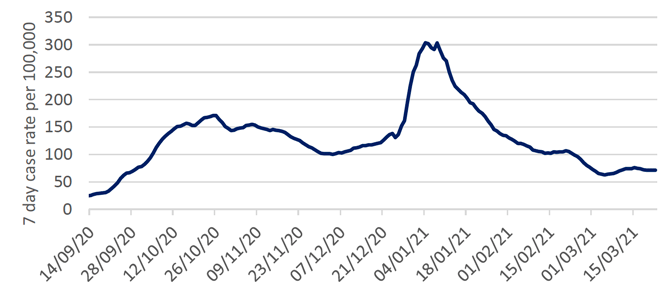
Case rates in most age groups have slightly decreased, with a slight increase in cases in those aged 0-19 this week (Figure 3).
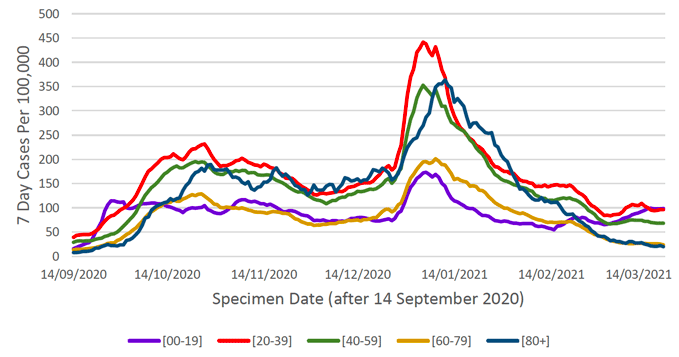
Not everyone who has the virus will be tested, as many people do not realise they have COVID, or have mild symptoms and do not come forward. Latest modelled estimates suggest there are currently anywhere between 710 and 1,640 people infected in Scotland each day[2]. This means that as of 24 March there were between 13 and 30 new daily infections per 100,000 people.
The number of people in hospital with confirmed Covid for less than 28 days is declining. After peaking at 2,053 on 22 January, this figure has decreased and as of 25 March there were 310 patients in hospital with COVID-19. In addition, there was a fall in daily hospital admissions for people with Covid from a peak of 242 on 11 January to 19 on 19 March[6].
There were 65 deaths registered where Covid was mentioned on the death certificate in the week to 21 March. This is a 38% decrease on the week before (104 deaths), and 90% lower than the peak in April 2020 (663 deaths). The proportion of deaths in care homes has decreased from 36% in mid-December to 9% of total deaths in the week to 21 March. Deaths involving coronavirus have declined most in those aged 85+ and have gone down by 85% over the 3 weeks to 21 March[7]. Deaths in those aged 65-84 and those aged 45-64 have declined by 65% and 64% respectively, over the same time (Figure 4).
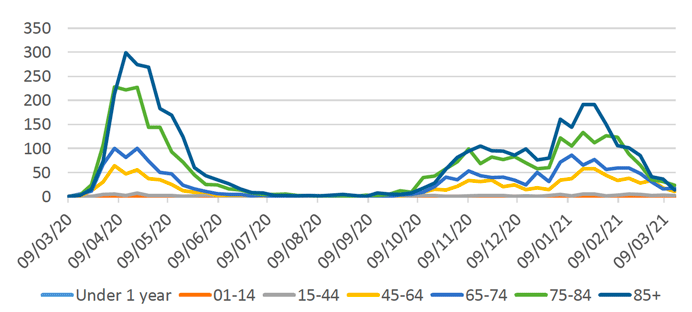
How Scotland compares with the rest of the UK
The recent ONS survey estimates that the proportion of the population infected in the community in Scotland (0.41% people currently testing positive for Covid-19 on 14-20 March) has increased slightly since last week and is now above England (0.30%), Northern Ireland (0.32%), and Wales (0.22%). In the week to the 20 March the estimated rate of community infection was 1 in 240 people in Scotland, compared to 1 in 340 for England, 1 in 450 for Wales and 1 in 320 for Northern Ireland[8]. Average daily deaths in Scotland (0.09 per 100,000 in the week to 24 March) are above Northern Ireland (0.06 per 100,000) however below England (0.12) and Wales (0.13 per 100,000).
Situation by local authority within Scotland
West Lothian currently has the highest case rates in Scotland with 209 weekly cases being reported per 100,000 in the week to 22 March. This is an increase of 83% from the week to 15 March[4]. There remains high or moderate levels of cases across large areas of Scotland (Figure 5). Local Authorities with increases greater than 20 cases per 100,000 include Dundee, Moray, West Dunbartonshire and West Lothian. Local Authorities with the biggest fall in cases in the last week include East Lothian, East Renfrewshire, Glasgow, Highland, Midlothian, North Ayrshire, Renfrewshire, South Ayrshire and Stirling. Argyll and Bute, Orkney and Scottish Borders currently have the lowest case rates at less than 10 per 100,000 each[4].
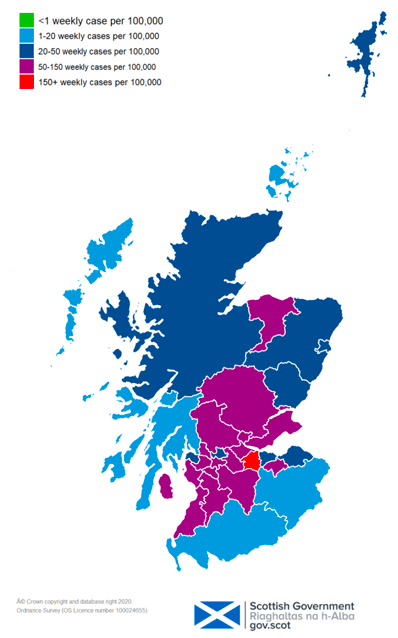
Children and Education
Recent easing of some restrictions in Scotland from 12 March allow up to 4 adults from 2 different households to meet outdoors. Young people (12 to 17 year olds) can meet outdoors in groups of up to 4 people from 4 different households, participate in non-contact outdoor sports in groups of up to 15 people, and travel across local authorities to participate in such activities.
Children in early learning and childcare and those in primaries 1-3 went back to school or nursery on 22 February, and all children in primaries 4-7 went back on the 15 March. There has also been a phased return to secondary schools, with some Senior Phase (S4-S6) pupils returning to school on a part-time basis to attend practical lessons from the 22 February and all secondary school pupils (S1-S6) returning on a part-time basis from the 15 March. Subject to continued suppression of the virus, all pupils are expected to return to full time education after the Easter break.
Since mid-February there has been an increase in the total number of COVID-19 infections in children (Figure 6)[5], with the highest proportion of cases currently observed in those aged 5 to 11. Alongside this there has been a substantial increase in testing for this age group, and an increasing proportion which are asymptomatic.
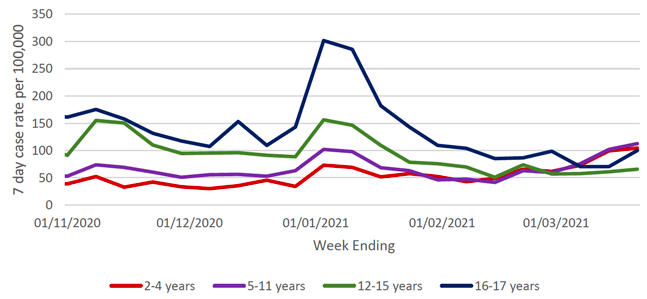
Overall, the proportion of primary school (P1-3) and early learning and childcare settings with incidents remains low. Where outbreaks have occurred these have been predominantly in areas with higher case rates in the local community.
Looking ahead
Changes in patterns of mixing and adherence to restrictions will impact on future case numbers. The Scottish Contact Survey measures times and settings that people mix where they could potentially spread Covid[2]. From this survey we can say that interactions have remained low since the beginning of January (currently 3.0 average daily contacts). In the last two weeks the largest increase in contacts have been reported for those aged over 70, reporting a rise in contacts within all settings. Individuals in this age group have also shown an increase in interactions with every age group. The largest increase in interactions is seen between those aged 40-49 with those under the age of 18 which coincides with the recent phased return of schools.
There is a high level of self-reported compliance with the Stay at Home regulations that came into effect on 5 January. On 23-24 March, 77% of people reported 'complete' or 'almost complete' compliance[9].
Hospital bed and ICU occupancy are projected to fall over the next few weeks, but with the potential to plateau or increase as a result of schools reopening (Figure 7)[2].
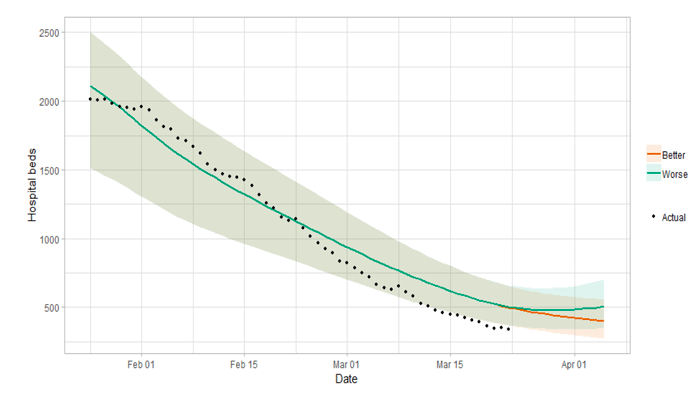
Vaccinations are continuing across the priority groups and just over 50% of the adult population in Scotland has now been vaccinated[4]. The first vaccines were administered on Tuesday 8 of December and 2,285,711 had received their first dose by 25 March 2021, a 13% increase from the 18 March[3]. By the 25 of March over 33,600 residents in care homes had received their first vaccination along with almost 50,000 care home staff, in older adult care homes over 85% of residents have now received their second dose. By age group, 98% of individuals aged 80 or over, almost a 100% of those aged 75-79 and 70-74, 98% of those aged 65-69, and 95% of those aged 60-64 had received their first vaccination (Figure 8). There are indications of decreasing hospitalisations and deaths among those groups vaccinated first (Figure 4).
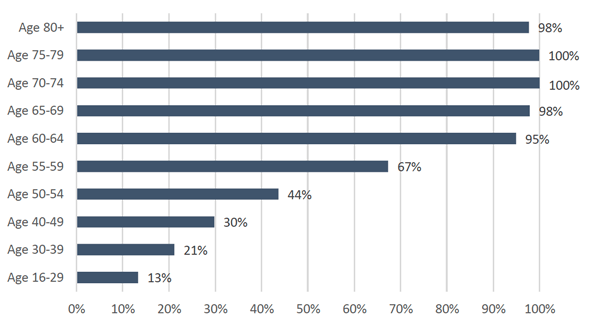
The proportion of people surveyed who said they would be likely to be vaccinated for COVID-19 remains high. 52% of all respondents have already received at least their first vaccine dose. Of those not vaccinated, 78% report they are likely to be vaccinated when a vaccine becomes available to them[11].
How the virus is changing
The variant of the virus commonly known as the UK variant (VOC-20DEC-01) has been increasing its share of confirmed cases since it was first detected in Scotland in mid-December and is now the dominant strain[12]. This new variant of Covid is more transmissible[13]. It is likely that infection with this variant is associated with an increased risk of hospitalisation and death compared to infection with non-VOC viruses[14].
Other variants of concern (VOCs) are being monitored by sequencing of SARS-CoV-2 samples. To date there are four VOCs and six variants under investigation[15]. Up to 24 March, there have been 22 genomically confirmed cases and 5 probable cases of the variant VOC-20DEC-02 (first seen in South Africa) detected in Scotland (an increase of 1 confirmed and 1 probable case from last week). There have been 3 confirmed and 1 probable case of the variant VOC-21JAN-02 (first identified from Brazil) (an increase of 1 confirmed case from last week). There is some concern, that some of these new variants may partially escape immunity, from both natural infection and from vaccines currently being deployed, and we are monitoring the evidence on this[16] [17] [18].
Next steps
The Scottish Government continues to work closely with Public Health Scotland to monitor the course of the epidemic using several data sources. Each week this report will provide an overview of current COVID-19 situation in Scotland. This will include real time data on case rates, hospitalisations and deaths and how Scotland's figures compare to those from the rest of the UK. Modelling can tell us where the epidemic is likely to be heading. Local data and data by age group can highlight where problem arise, which can help in addressing some of these issues. In the coming weeks the roll out of the vaccine will continue to be monitored along with the impact of this on case rates and deaths among different age cohorts. Investigations are ongoing by NERVTAG, SPI-M, SAGE, Public Health England and Public Health Scotland regarding the impact of new variants and of vaccination, this will be reflected here as work is undertaken.
Contact
There is a problem
Thanks for your feedback